 Libri di Philip Haythornthwaite su Unilibro.it) Libri di Philip Haythornthwaite su Unilibro.it)
|
|
2025 |
 Title :
La battaglia di Borodino. 1812. Il grande azzardo di Napoleone
Title :
La battaglia di Borodino. 1812. Il grande azzardo di NapoleoneAuthor: Haythornthwaite Philip Publisher: LEG Edizioni Nella battaglia di Borodino, la più importante che si svolse durante l'invasione della Russia da parte di Napoleone nel 1812, l'imponente Grande Armée dell'imperatore, formata da soldati di numerosi Stati entrati nella sfera d'influenza francese, fronteggiò un tenace esercito russo agli ordini del maresciallo Kutuzov. Dopo una sanguinosa serie di attacchi frontali e di disperati contrattacchi, i due schieramenti si annientarono a vicenda, ma Napoleone non cedette terreno e marciò su Mosca, da dove sarebbe iniziata la tragica ritirata verso la salvezza. Questo libro abbraccia la campagna del 1812 nella sua interezza, dall'ingresso dell'esercito francese in territorio russo, in giugno, fino al suo ripiegamento, sotto le incessanti molestie delle truppe nemiche lungo il percorso oltre la Vistola; la battaglia di Borodino è il punto su cui s'incentra tutta la narrazione. € 18,00
Scontato: € 17,10
|
|
|
1918 |
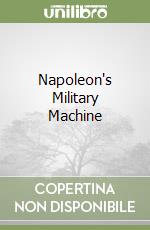 Title :
Napoleon's Military Machine
Title :
Napoleon's Military MachineAuthor: Haythornthwaite Philip J. Publisher: History Pr Ltd € 20,30
|
|
|
2018 |
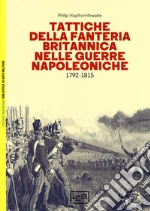 Title :
Tattiche della fanteria britannica nelle guerre napoleoniche (1792-1815)
Title :
Tattiche della fanteria britannica nelle guerre napoleoniche (1792-1815)Author: Haythornthwaite Philip Publisher: LEG Edizioni Il commento del duca di Wellington sulla fanteria britannica, espresso poco prima dell'inizio della campagna di Waterloo (1815), è ben noto: alla domanda su quale sarebbe stato il risultato dei combattimenti che stavano per cominciare, egli indicò un fante fuori servizio e disse: 'Dipende tutto da quell'articolo se riusciremo a fare il lavoro oppure no. Se me ne date abbastanza, ne sono sicuro'. Le ragioni che al tempo, così come in seguito, furono addotte per spiegare l'eccellenza della fanteria includevano fattori quali la caparbietà e la determinazione del singolo soldato, la disciplina, le capacità dei comandanti e il sistema reggimentale. Questi e altri elementi sono presi in esame nel libro attraverso uno studio accurato, in grado di fornire una panoramica completa e avvincente sulla fanteria britannica nel contesto delle guerre napoleoniche. € 18,00
Scontato: € 17,10
|
|
|
1917 |
 Title :
In the Peninsula With a French Hussar
Title :
In the Peninsula With a French HussarAuthor: De Rocca Albert Jean Michel, Haythornthwaite Philip J. (INT) Publisher: Frontline Books € 37,00
|
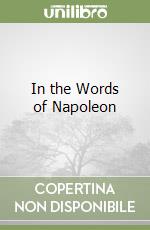 Title :
In the Words of Napoleon
Title :
In the Words of NapoleonAuthor: Johnston R. M. (EDT), Haythornthwaite Philip J. (CON) Publisher: Frontline Books € 35,70
|
|
1916 |
 Title :
British Light Infantry & Rifle Tactics of the Napoleonic Wars
Title :
British Light Infantry & Rifle Tactics of the Napoleonic WarsAuthor: Haythornthwaite Philip J., Hook Adam (ILT) Publisher: Osprey Pub Co € 14,40
|
|
|
2016 |
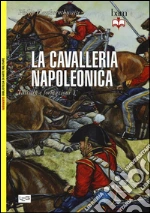 Title :
La cavalleria napoleonica. Tattiche e formazioni
Title :
La cavalleria napoleonica. Tattiche e formazioniAuthor: Haythornthwaite Philip Publisher: LEG Edizioni Durante le guerre napoleoniche, la più importante arma risolutiva sul campo di battaglia fu la cavalleria pesante, rappresentata dai corazzieri francesi e dai loro omologhi britannici, austriaci, prussiani e russi. Questa specialità era formata da uomini prestanti montati su cavalli di notevole stazza, armati con sciabole lunghe quasi un metro con le quali potevano colpire sia di taglio sia di punta. Molti di essi indossavano corazze d'acciaio, una pratica antica riportata in auge da Napoleone. I reparti della cavalleria pesante avevano il compito di aprire una breccia nello schieramento nemico, magari sfruttandone un punto debole o aggirandone un fianco. La loro manovra classica era la carica: disposti in linee o in colonne a ranghi serrati, avrebbero cominciato l'attacco al passo, aumentando l'andatura fino al galoppo per gli ultimi 50 metri prima dell'impatto fatale. Nello stesso periodo, tutti gli eserciti belligeranti misero in campo anche numerosi reggimenti di cavalleria leggera. Agili e veloci, queste unità svolgevano una serie di compiti essenziali che spaziavano dalla ricognizione all'incursione, dall'azione di disturbo all'inseguimento e distruzione di forze nemiche già sconfitte, ma non era raro che venissero impiegate anche per caricare fianco a fianco con le unità 'pesanti'. Corredato da illustrazioni d'epoca, grafici e tavole a colori appositamente realizzati, questo libro raccoglie due studi sulle tattiche di cavalleria negli eserciti di Napoleone e in quelli dei suoi alleati e nemici. € 24,00
|
 Title :
Le campagne di Napoleone in Italia
Title :
Le campagne di Napoleone in ItaliaAuthor: Haythornthwaite Philip Publisher: LEG Edizioni Nel gennaio 1794 l'Armata d'Italia francese, in condizioni di crescente precarietà, era guidata dal generale Dumerbion: tra i suoi collaboratori più fidati c'era un comandante d'artiglieria di venticinque anni che si era già saputo mettere in luce, Napoleone Bonaparte. La rivoluzione francese aveva portato cambiamenti notevoli nel sistema militare: primo fra tutti, la coscrizione che diede l'avvio al formarsi di un esercito nazionale. L'utilizzo di nuove tattiche e alcune notevoli iniziative consentirono al brillante ufficiale Bonaparte di farsi strada rapidamente e avanzare di grado. Nel 1796 il giovane corso era al comando delle forze francesi in Italia e, alla conclusione di una campagna di quattordici mesi, era la personalità militare più influente della sua epoca. Gli scontri dei francesi contro le forze austriache e degli Stati italiani sono ripercorsi in una narrazione accurata: il ponte di Lodi, l'assedio di Mantova, Rivoli, Arcole e tutte le battaglie della campagna sono ricostruite accuratamente anche grazie a mappe e illustrazioni. Specifiche tavole a colori sono dedicate ad esaminare in dettaglio le uniformi dei soldati. Un momento cruciale della storia d'Europa e del cammino di Napoleone verso la gloria in un racconto avvincente e ricco di dettagli. € 18,00
Scontato: € 17,10
|
|
2015 |
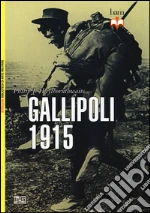 Title :
Gallipoli 1915
Title :
Gallipoli 1915Author: Haythornthwaite Philip; Pagliano M. (cur.) Publisher: LEG Edizioni La spedizione di Gallipoli del 1915 fu pianificata dagli inglesi per mettere fuori gioco l'Impero ottomano nella Prima guerra mondiale e per aprire una via di comunicazione che permettesse di far giungere rifornimenti alla Russia. La campagna fu caratterizzata dall'incompetenza militare degli alti comandi dell'Intesa. Tuttavia, Gallipoli viene ricordata anche per il sacrificio e l'eroismo sia delle forze britanniche sia dei soldati del corpo d'armata australiano e neozelandese (ANZAC). Il libro descrive in dettaglio le battaglie e le progressive difficoltà, fino all'evacuazione finale, che questi uomini dovettero affrontare, proponendosi come una guida completa alle operazioni nella penisola di Gallipoli. € 18,00
Scontato: € 17,10
|
|
|
1913 |
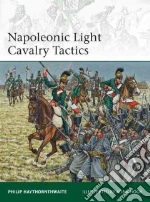 Title :
Napoleonic Light Cavalry Tactics
Title :
Napoleonic Light Cavalry TacticsAuthor: Haythornthwaite Philip J., Hook Adam (ILT) Publisher: Osprey Pub Co During the Napoleonic Wars, all the major combatants fielded large numbers of light cavalry as Hussars, Dragoons, Chasseurs, Lancers, or even Cossacks. Ridley Scott's 1977 feature film debut The Duelists portrayed French Hussars. Light cavalry provided nimble, fast-moving regiments that performed a variety of vital roles, from reconnaissance and keeping contact with the enemy during the movement of armies, to raiding, skirmishing, and the pursuit to destruction of beaten enemies. In practice, light cavalry were often also employed for battlefield charges alongside the heavy cavalry. The light cavalryman typically carried a curved sabre, one or two pistols and sometimes a carbine, and rode a smaller horse than his counterpart in the heavy cavalry. As the Napoleonic Wars progressed, the dashing Chasseurs and Light Dragoons and glamorous Hussars were joined by growing numbers of Lancers, while the Russians employed vast numbers of Cossacks. Often the first to engage the enemy, these colourful regiments saw combat on a host of bloody battlefields across Europe. Featuring period illustrations and specially commissioned colour artwork, this is the second volume of a two-part study of the cavalry tactics of the armies of Napoleon and those of his allies and opponents. Written by a leading authority on the period, it draws upon drill manuals and later writings to offer a vivid assessment of how light cavalry actually fought on the Napoleonic battlefield. € 17,60
|
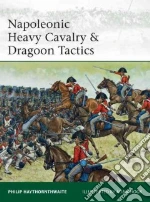 Title :
Napoleonic Heavy Cavalry & Dragoon Tactics
Title :
Napoleonic Heavy Cavalry & Dragoon TacticsAuthor: Haythornthwaite Philip J., Hook Adam (ILT) Publisher: Osprey Pub Co During the Napoleonic Wars the supreme battlefield shock weapon was the heavy cavalry - the French cuirassiers, and their British, Austrian, Prussian and Russian counterparts. Big men mounted on big horses, the heavy cavalry were armed with swords nearly a metre long, used for slashing or thrusting at their opponents; many wore steel armour, a practice revived by Napoleon. They were tasked with smashing a hole in the enemy's line of battle, with exploiting a weakness, or with turning a flank. Their classic manoeuvre was the charge; arrayed in close-order lines or columns, the heavy cavalry would begin their attack at the walk, building up to a gallop for the final 50 metres before impact. Illustrated with diagrams, relevant paintings and prints and specially prepared colour plates, this is the first volume of a two-part study of the cavalry tactics of the armies of Napoleon and those of his allies and opponents. Written by a leading authority on the period, it draws upon drill manuals and later writings to offer a vivid assessment of how heavy cavalry actually fought on the Napoleonic battlefield. € 17,60
|
|
1912 |
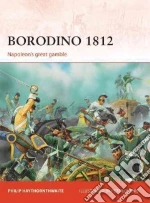 Title :
Borodino 1812
Title :
Borodino 1812Author: Haythornthwaite Philip J., Dennis Peter (ILT) Publisher: Osprey Pub Co The battle of Borodino was one of the greatest encounters in European history, and one of the largest and most sanguinary in the Napoleonic Wars. Following the breakdown of relations between Russia and France, Napoleon assembled a vast Grande Armée drawn from the many states within the French sphere of influence. They crossed the river Neimen and entered Russian territory in June 1812 with the aim of inflicting a sharp defeat on the Tsar's forces and bringing the Russians back into line. In a bloody battle of head-on attacks and desperate counter-attacks in the village of Borodino on 7 September 1812, both sides lost about a third of their men, with the Russians forced to withdraw and abandon Moscow to the French. However, the Grande Armée was harassed by Russian troops all the way back and was destroyed by the retreat. The greatest army Napoleon had ever commanded was reduced to a shadow of frozen, starving fugitives. This title will cover the events of Napoleon's disastrous Russian campaign of 1812 in its entirety, with the set-piece battle of Borodino proving the focal point of the book. € 20,30
|
|
|
2008 |
 Title :
British Napoleonic Infantry Tactics 1792-1815
Title :
British Napoleonic Infantry Tactics 1792-1815Author: Haythornthwaite Philip J., Noon Steve (ILT) Publisher: Osprey Pub Co Osprey's study of Britain's infantry tactics used during the Napoleonic Wars (1799-1815). The British Army's major campaigns against Napoleon were fought between 1808 and 1813 in the Peninsula (Portugal, Spain, and finally southern France), followed in 1815 by the brief but climactic Waterloo campaign. The British Army was small by continental standards, but it consistently out-fought larger French armies, never losing a major open-field action. Its cavalry and artillery were standard; but its infantry which unlike foreign armies, was entirely made up of volunteers, achieved unique results. Their tactics were brought to a peak of professional perfection by Wellington, but commentators still consistently over-simplify the explanation for his unmatched series of victories. This book will examine the contemporary instruction manuals, and compare them with what actually happened in specific battles, drawing upon a mass of quotations from eyewitnesses. Under other generals who failed to grasp the essentials, the British infantry could be beaten (occasionally) by both the French, and by the Americans; but it was Wellington's perfect employment of their tactical strengths that made them unstoppable. With a detailed look at the effective use of terrain, line vs column maneuvers, and fortification assaults, Philip Haythornthwaite reveals the outstanding tactics of Wellington's army that converted volunteers into war-winning professionals. € 17,60
|
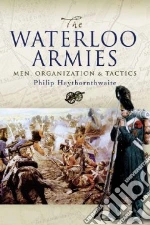 Title :
The Waterloo Armies
Title :
The Waterloo ArmiesAuthor: Haythornthwaite Philip J. Publisher: Pen & Sword Waterloo scholar Haythornthwaite writes on the national armies at Waterloo, the French and British as well as the Hanoverians, the Brunswickers, Netherlanders, and Prussians. The British Allied troops and the French are studied most closely, with sections discussing each command and staff, infantry, cavalry, artillery, and supporting services. This title is intended for the general public with a particular interest in military history or the Battle of Waterloo. Distributed by Casemate. Annotation ©2008 Book News, Inc., Portland, OR (booknews.com) € 35,70
|
|
2005 |
 Title :
Peninsular War
Title :
Peninsular WarAuthor: Haythornthwaite Philip J. Publisher: Casemate Pub & Book Dist Llc Haythornthwaite is an internationally respected author and historical consultant specializing in the military history of the Napoleonic War, and has written some 40 books. He presents a compact reference text for students and historians which divides the wars and campaigns into thematic sections: chronology, the leading participants, and the organization and establishment of the armies involved France, Great Britain, Holland, Italy, Naples, Portugal, The Rheinbund, Sicily, and Spain. The text also includes several aids to further study including a glossary; list of references; orders of battle; a listing of battles, number and losses; table of Peninsular War causalities; measurements of distance; sieges; and brief description of the provinces of Iberia. Distributed in the U.S. by Casemate. Annotation ©2005 Book News, Inc., Portland, OR (booknews.com) € 24,20
|
|
|
2001 |
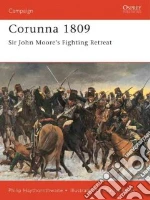 Title :
Corunna 1809
Title :
Corunna 1809Author: Haythornthwaite Philip J. Publisher: Osprey Pub Co The retreat to Corunna is one of the epic campaigns of the Napoleonic Wars (1799-1815). Late in 1808 Sir John Moore found himself virtually alone with his small British army deep inside Spain. The armies of his Spanish allies had been overwhelmed and he faced a victorious French force under the Emperor Napoleon. He had little option but to order a retreat to the port of Corunna. This became the most arduous of trials with armies traversing mountainous terrain over appalling roads in the depths of winter. Somehow Moore held his outnumbered, exhausted men together as they struggled to reach safety. Finally at Corunna Moore's army turned to face its tormentors. € 21,40
|
|
|
1998 |
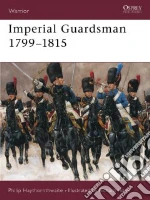 Title :
Imperial Guardsman 1799-1815
Title :
Imperial Guardsman 1799-1815Author: Haythornthwaite Philip J., Hook Richard (ILT) Publisher: Osprey Pub Co Napoleon's Imperial Guard was one of the most famous military formations in history. The Imperial Guard could perform ceremonial duties as well as any, but it was primarily as an élite combat formation of the army that it excelled. Although it would expand to represent a considerable portion of France's military establishment, it remained Napoleon's personal guard during the Napoleonic Wars (1799-1815) and was accorded care and attention which set its members above the rest of the army. In this book, Philip Haythornthwaite examines their lives, organisation and privileges, paying particular attention to how their experience differed from those of the regular French line units. € 17,00
|
|
|
1992 |
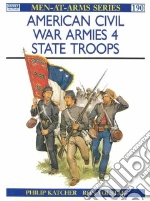 Title :
American Civil War Armies
Title :
American Civil War ArmiesAuthor: Philip J Haythornthwaite Publisher: OSPREY 'The War between the States' is the term used for the American Civil War (1861-1865)throughout much of the South even today. Many on both sides – not just the South – felt that they were serving their states as much, if not more, than their central governments. Many of the states agreed; the state governments raising their own units, commissioning their officers, and supplying their men. Indeed, many of the units that fought the Civil War were supplied in large part by their own states rather than by the central government's quartermasters. Philip Katcher's fascinating text explores the uniforms of 32 states; from Alabama to Wisconsin. € 13,10
|
|
|
1991 |
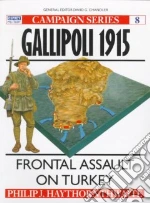 Title :
Gallipoli 1915
Title :
Gallipoli 1915Author: Haythornthwaite Philip J. Publisher: Osprey Pub Co The Gallipoli expedition of 1915, the brainchild of Winston Churchill, was designed to knock the Turkish Empire out of the First World War and open a supply route to Russia. The campaign is characterised by the military incompetence of the higher commands, particularly the Allies. However, in spite of this, Gallipoli deserves to be, and is, also remembered for the heroism and resourcefulness of both the British army and the men of the Australian and New Zealand Army Corps. This book details the battles, hardships and eventual evacuation that these men had to go through, in this comprehensive guide to the Gallipoli landings of World War I (1914-1918). € 17,90
|
|
|
1983 |
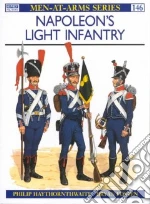 Title :
Napoleon's Light Infantry
Title :
Napoleon's Light InfantryAuthor: Philip J Haythornthwaite Publisher: OSPREY Although light infantry tactics formed one of the cornerstones of the Napoleonic Wars (1799-1815), their employment was by no means restricted to Light regiments. Thus, from the early 1800s, if not before, the distinction between Light and Line infantry was largely one of costume and tradition. One marked difference from the Line infantry, however, was in the superior ésprit de corps of the Light regiments. Their attitude of superiority was reinforced by their different (and often more impressive) uniform, the theoretical difference in role, and supposed superior training. Philip Haythornwaite examines their uniforms in a volume including eight superb colour plates by Brian Fosten. € 13,10
|